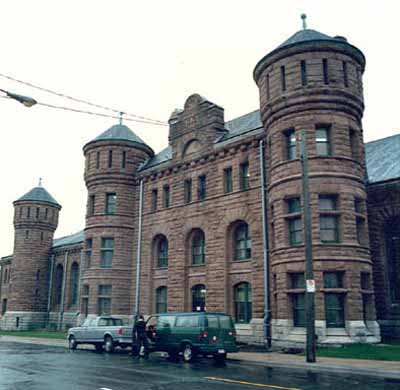Halifax Drill Hall National Historic Site of Canada
Halifax, Nova Scotia

Corner view
© Department of National Defence/ Ministère de la Défence nationale, 1990.
Address :
2667 North Park Street, Halifax, Nova Scotia
Recognition Statute:
Historic Sites and Monuments Act (R.S.C., 1985, c. H-4)
Designation Date:
1989-06-22
Dates:
-
1895 to 1899
(Construction)
Event, Person, Organization:
-
Thomas Fuller
(Architect)
Other Name(s):
-
Halifax Drill Hall
(Designation Name)
-
Halifax Armoury
(Other Name)
-
Halifax Armoury
(Plaque name)
DFRP Number:
02914 00
Plaque(s)
Existing plaque: 2667 North Park Street, Halifax, Nova Scotia
The federal government built this impressive drill hall between 1895 and 1899 as part of the reform and expansion of the Active Militia. Planned as a fully-equipped training centre, it was substantially larger than most earlier drill halls and boasted such novel features as an indoor shooting gallery and lecture rooms. The robust style, suggestive of the medieval fortress, shows the influence of Chief Architect Thomas Fuller. Its bold imagery and sophisticated plan perfectly captured the spirit of militia reform and influenced Canadian drill hall design for several decades.
Description of Historic Place
Halifax Drill Hall National Historic Site of Canada is a large building situated across from the common in north central Halifax, Nova Scotia. Built of red, rock-faced stone in a Richardsonian Romanesque style, the principal façade of the drill hall is distinguished by an arched troop door set under a large round-arched window and flanked by smaller arched windows and matching corner towers. Its distinguishing interior feature is its large unobstructed drill hall space. Official recognition refers to the building on its legal lot.
Heritage Value
Halifax Drill Hall was designated a national historic site of Canada in 1989 because: it is a good representative example from the second evolutionary stage in drill hall construction in Canada (1872-1895); planned as a fully-equipped training centre, it is substantially larger than most earlier drill halls and boasts such novel features as an indoor shooting gallery and lecture rooms; its bold imagery and sophisticated plan perfectly captured the spirit of militia reform and influenced Canadian drill hall design for several decades.
The Halifax Drill Hall is a bold functional design wrapped in a rugged Richardsonian Romanesque style designed by Thomas Fuller, then Chief Architect of the Federal Department of Public Works. His designs, including that of the Halifax Drill Hall, provided the Canadian drill hall with an architectural vocabulary, which expressed the military nature of the buildings so well that it was used for a number of structures long after Fuller had left the department.
Built in response to demands made by the militia in Halifax for a larger drill hall capable of training their growing number of militiamen, the Halifax Drill Hall was significantly larger than most other Canadian drill halls. Its huge size gave the militia one of the largest uninterrupted interior spaces in Canada. In order to create this large open interior space, triangular steel Fink trusses were used, marking the first time all-metal trusses were used in Canadian drill halls. Proving very satisfactory, the use of this truss system was adopted by the federal government for almost all larger drill halls constructed before the First World War.
Also innovative to the Canadian drill hall was the addition of an indoor shooting gallery, as well as libraries and lecture rooms, which ensured drill and rifle training would be supplemented with classroom instruction. Complete with billiard rooms for the officers and bowling alleys for the men, the Halifax Drill Hall functioned as both a fully equipped training centre and a recreational club.
The Halifax Drill Hall is also associated with the Princess Louise Fusiliers, formed in 1869, who saw action in the Riel Rebellion, the South African War and both World Wars.
Source: Historic Sites and Monuments Board of Canada, Minutes, June 1989.
Character-Defining Elements
Key elements that contribute to the heritage value of this site include: the prominent location in downtown Halifax; the rectangular massing under a medium-pitch gable roof; the rock-faced stone construction of the exterior walls and the triangular steel Fink roof trusses; the principal, symmetrically organized gable-end façade with its central troop door set under a large round arched drill hall window flanked by triple double-height, round-headed windows and conically roofed towers; the Richardsonian Romanesque style exterior detailing, notably carved stonework, stringcourses, corbelled banding, and deep set multi-pane windows with heavy mullions with wide voussoirs above; the large unobstructed interior space of the drill hall and purpose-built spaces such as the indoor shooting range.